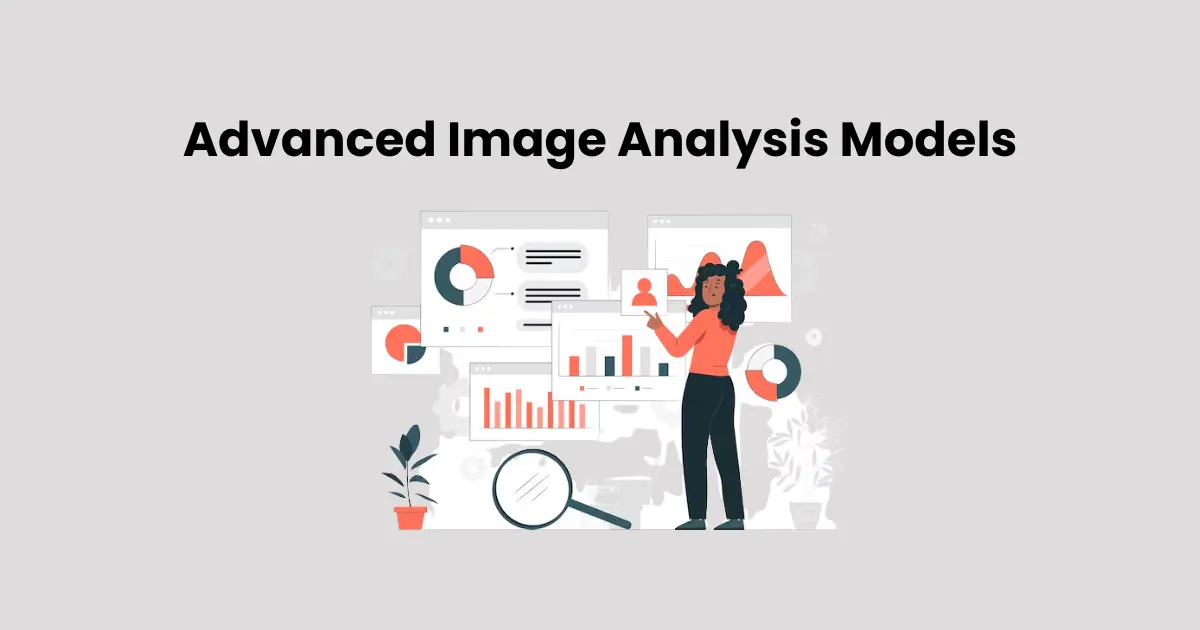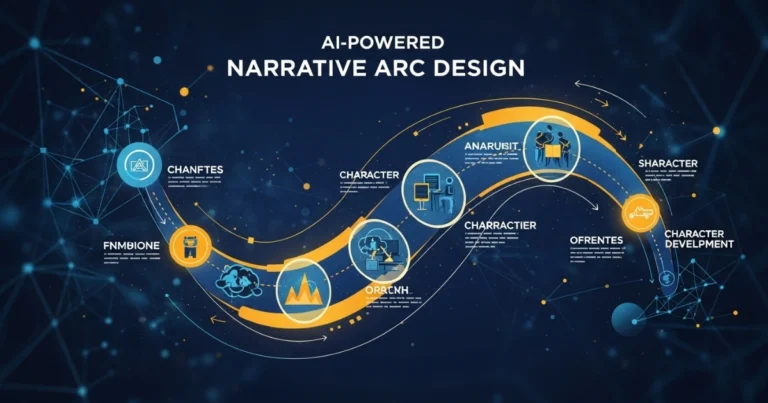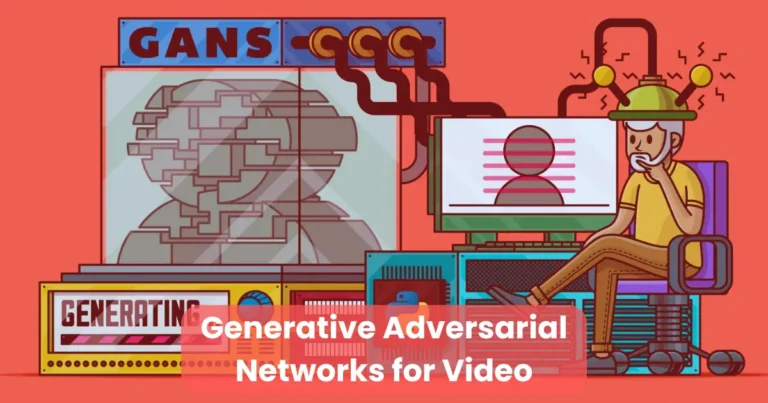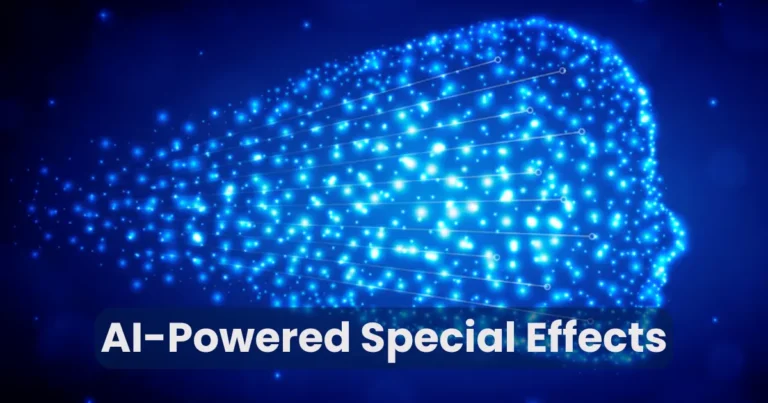Advanced Image Analysis Models | Types of Advanced Image Analysis

Contents
- 1 Understanding Image Analysis Models
- 2 Types of Advanced Image Analysis Models
- 3 Key Applications of Advanced Image Analysis Models
- 4 How Advanced Image Analysis Models Work
- 5 Challenges in Developing Advanced Image Analysis Models
- 6 Future Trends in Image Analysis Technology
- 6.1 1. Integration of Vision Transformers (ViTs)
- 6.2 2. Explainable AI (XAI) for Image Analysis
- 6.3 3. Self-Supervised and Few-Shot Learning
- 6.4 4. Real-Time and Edge AI Processing
- 6.5 5. Generative AI for Image Enhancement
- 6.6 6. AI-Powered 3D Image Analysis
- 6.7 7. Ethical AI and Bias Mitigation
- 6.8 Conclusion
The rapid growth of artificial intelligence has led to significant advancements in advanced image analysis models. These models leverage deep learning and machine learning algorithms to interpret, classify, and process visual data with remarkable accuracy. As industries increasingly rely on automation, the demand for cutting-edge image analysis solutions continues to rise. From healthcare and security to autonomous systems and e-commerce, these models play a crucial role in extracting meaningful insights from images.
Over the years, the evolution of advanced image analysis models has transformed traditional computer vision techniques. Earlier methods relied on manual feature extraction, whereas modern approaches use deep neural networks for automated learning and adaptation. With continuous improvements in computational power and data availability, these models are becoming more efficient, scalable, and precise.
This article explores the core concepts of advanced image analysis models, their types, applications, working mechanisms, challenges, and future trends. By understanding these aspects, businesses and researchers can harness the full potential of these models to drive innovation and efficiency.
Understanding Image Analysis Models
To grasp the significance of advanced image analysis models, it is essential to understand their fundamentals. These models are designed to process and interpret digital images, enabling machines to recognize patterns, detect objects, and extract valuable information. By leveraging deep learning techniques, they can achieve levels of accuracy that surpass traditional image processing methods.
What Are Image Analysis Models?
Image analysis models are artificial intelligence (AI)-driven algorithms that analyze visual data to perform tasks such as classification, segmentation, object detection, and feature extraction. Unlike conventional image processing, which relies on manually defined rules, these models learn patterns from vast datasets, improving their accuracy over time.
Evolution of Image Analysis Technology
The development of advanced image analysis models has undergone several stages, each bringing significant improvements:
- Traditional Computer Vision – Early image analysis relied on handcrafted features such as edge detection and histogram-based techniques. However, these methods struggled with variations in lighting, angles, and object complexity.
- Machine Learning-Based Approaches – The introduction of machine learning allowed models to recognize features more effectively by using statistical learning techniques. Yet, feature engineering remained a challenge.
- Deep Learning Revolution – The rise of deep learning, particularly Convolutional Neural Networks (CNNs), transformed image analysis by enabling models to automatically extract hierarchical features from images.
- State-of-the-Art AI Models – Recent advancements have led to sophisticated architectures such as Vision Transformers (ViTs), Generative Adversarial Networks (GANs), and Autoencoders, further enhancing image analysis capabilities.
With continuous innovation in AI and computational power, advanced image analysis models are becoming more efficient, enabling breakthroughs across various industries. The next section delves into the different types of these models and their functionalities.
Types of Advanced Image Analysis Models
Several cutting-edge advanced image analysis models have emerged, each designed to solve specific challenges in visual data processing. These models utilize deep learning architectures to enhance accuracy, efficiency, and adaptability. Below are the most widely used types:

1. Convolutional Neural Networks (CNNs)
CNNs are the backbone of most advanced image analysis models. They process images through multiple layers, automatically extracting features such as edges, textures, and patterns. By using convolutional layers, pooling layers, and fully connected layers, CNNs excel at tasks such as:
- Image Classification (e.g., recognizing cats vs. dogs)
- Object Detection (e.g., detecting pedestrians in autonomous vehicles)
- Image Segmentation (e.g., medical imaging applications)
Popular CNN architectures include AlexNet, VGGNet, ResNet, and EfficientNet, each improving model efficiency and accuracy.
2. Vision Transformers (ViTs)
Unlike CNNs, Vision Transformers (ViTs) use self-attention mechanisms instead of convolutions to analyze images. By breaking an image into smaller patches and processing them like sequences of data, ViTs can capture long-range dependencies within an image. These models have shown remarkable performance in:
- High-resolution image recognition
- Medical imaging analysis
- Fine-grained object detection
ViTs are gaining popularity due to their scalability and ability to outperform CNNs in specific vision tasks.
3. Generative Adversarial Networks (GANs)
GANs are a unique class of advanced image analysis models that generate realistic images by using two competing neural networks:
- Generator – Creates synthetic images
- Discriminator – Evaluates the authenticity of generated images
GANs are widely used for:
- Image super-resolution (enhancing low-quality images)
- Deepfake creation (synthesizing human faces and videos)
- Art and design (AI-generated artwork and textures)
4. Autoencoders and Their Applications
Autoencoders are neural networks designed for unsupervised learning, primarily used for image compression, noise reduction, and anomaly detection. These models consist of two main parts:
- Encoder – Compresses the image into a latent representation
- Decoder – Reconstructs the image from the compressed data
Applications of autoencoders include:
- Denoising images in photography and medical imaging
- Anomaly detection in industrial quality control
- Dimensionality reduction for image classification tasks
Each of these advanced image analysis models contributes to enhancing machine perception and automation in diverse fields. The next section explores their practical applications in real-world scenarios.
Key Applications of Advanced Image Analysis Models
With the continuous evolution of artificial intelligence, advanced image analysis models have found applications in multiple industries. These models enhance automation, improve accuracy, and enable real-time decision-making. Below are some of the most impactful applications:

1. Medical Imaging and Disease Detection
One of the most crucial applications of advanced image analysis models is in healthcare. AI-powered models assist doctors in diagnosing diseases, detecting abnormalities, and analyzing medical scans with precision.
- MRI and CT Scan Analysis – CNNs help in identifying tumors, fractures, and organ anomalies.
- X-ray Interpretation – AI detects signs of pneumonia, tuberculosis, and COVID-19.
- Histopathology – GANs and autoencoders analyze microscopic tissue images for cancer detection.
By improving diagnostic accuracy and reducing manual workload, AI-driven image analysis is transforming modern healthcare.
2. Autonomous Vehicles and Object Recognition
Self-driving cars rely on advanced image analysis models for real-time object detection and navigation. AI-powered vision systems process video feeds from cameras to:
- Detect pedestrians, traffic lights, and road signs
- Classify vehicles and obstacles
- Enable lane detection and depth estimation
CNNs and Vision Transformers (ViTs) play a critical role in ensuring safety and efficiency in autonomous driving systems.
3. Security and Facial Recognition
AI-powered image analysis models enhance security through facial recognition, surveillance, and biometric authentication. These models analyze facial features to:
- Authenticate users in banking and mobile devices
- Detect unauthorized access in restricted areas
- Identify suspects in law enforcement applications
GANs and autoencoders are also used in forensic image restoration and deepfake detection.
4. E-Commerce and Product Recommendations
In online retail, advanced image analysis models improve user experience through personalized recommendations and visual search. AI-driven systems enable:
- Automatic tagging and categorization of products
- Visual search engines that match images to similar products
- Augmented reality (AR) applications for virtual try-ons
Major e-commerce platforms leverage CNNs and deep learning algorithms to enhance product discovery and customer engagement.
From healthcare to e-commerce, advanced image analysis models are driving innovation across multiple sectors. The next section explores how these models function and the techniques that enhance their performance.
How Advanced Image Analysis Models Work
The effectiveness of advanced image analysis models comes from their ability to process visual data efficiently using deep learning techniques. These models undergo multiple steps, from data preprocessing to final predictions, ensuring high accuracy and reliability.

1. Data Preprocessing and Feature Extraction
Before feeding images into an AI model, preprocessing is crucial to improve performance. The key preprocessing steps include:
- Image Resizing – Standardizing dimensions for consistency
- Normalization – Adjusting pixel values to a common scale
- Data Augmentation – Rotating, flipping, and scaling images to enhance model generalization
- Noise Reduction – Removing artifacts for clearer image analysis
Feature extraction is another vital step where the model identifies edges, textures, colors, and object shapes to recognize patterns. Unlike traditional computer vision techniques, deep learning automates this process, making it more efficient.
2. Training and Optimization Techniques
Once data is preprocessed, advanced image analysis models are trained using large datasets. The training process involves:
- Forward Propagation – The model predicts outputs based on input images
- Loss Calculation – The error between the predicted and actual result is measured
- Backpropagation – The model updates its parameters to reduce errors
- Optimization Algorithms – Methods like Adam, SGD, and RMSprop fine-tune learning rates for better accuracy
CNNs, Vision Transformers (ViTs), and GANs use deep architectures to learn hierarchical representations of images. These layers help detect simple features at lower levels and complex patterns at higher levels.
3. Model Evaluation and Performance Metrics
After training, advanced image analysis models are evaluated to ensure accuracy and reliability. The most common evaluation metrics include:
- Accuracy – Measures the percentage of correct predictions
- Precision & Recall – Evaluates the model’s ability to identify relevant features
- F1-Score – A balance between precision and recall
- Mean Average Precision (mAP) – Used in object detection models
- Intersection over Union (IoU) – Measures the overlap between predicted and actual object locations
By fine-tuning hyperparameters and applying regularization techniques, models achieve higher performance and avoid overfitting.
With robust training methodologies, advanced image analysis models continue to improve, enabling groundbreaking advancements in AI-powered vision systems. However, certain challenges still exist, which will be explored in the next section.
Challenges in Developing Advanced Image Analysis Models
Despite their impressive capabilities, advanced image analysis models face several challenges that impact their development, deployment, and performance. These obstacles stem from data complexities, computational requirements, and ethical considerations.

1. High Computational Costs and Resource Demand
Training deep learning models requires significant computational power. Processing high-resolution images and running complex architectures such as CNNs, Vision Transformers (ViTs), and Generative Adversarial Networks (GANs) demand:
- High-performance GPUs or TPUs – Essential for training large-scale models
- Massive storage capacity – Required for handling large datasets
- Extended training times – Some models take days or weeks to train
Due to these resource-intensive requirements, deploying advanced image analysis models in real-time applications can be costly.
2. Data Quality and Annotation Challenges
AI models rely heavily on large, well-annotated datasets. However, obtaining high-quality labeled data presents several challenges:
- Data Scarcity – Some domains, such as medical imaging, lack sufficient labeled datasets
- Annotation Complexity – Labeling images for segmentation or object detection is time-consuming and expensive
- Data Bias – If training datasets are not diverse, models may develop biases, leading to inaccurate predictions
To address these issues, researchers use data augmentation, transfer learning, and synthetic data generation techniques.
3. Overfitting and Generalization Issues
One of the biggest hurdles in deep learning is overfitting, where models memorize training data instead of learning general patterns. Overfitted models perform well on training images but fail in real-world scenarios. Factors contributing to overfitting include:
- Limited training data – Causes models to rely on specific patterns rather than general features
- Excessive model complexity – Too many layers can lead to memorization instead of abstraction
- Lack of diversity in training images – Models struggle with unseen variations
Regularization techniques such as dropout, L2 regularization, and batch normalization help mitigate overfitting.
4. Ethical and Privacy Concerns
As advanced image analysis models become more widespread, ethical considerations arise, particularly in facial recognition and surveillance applications. Challenges include:
- Privacy Violations – AI-powered facial recognition raises concerns about unauthorized data collection
- Bias and Fairness – Models trained on unbalanced datasets may discriminate against certain demographics
- Deepfake Misuse – GANs enable the creation of highly realistic fake images, leading to misinformation threats
Regulatory frameworks and AI ethics guidelines aim to ensure responsible AI development and deployment.
5. Real-Time Processing Limitations
Many applications, such as autonomous driving and medical diagnostics, require real-time image analysis. However, achieving low-latency processing is challenging due to:
- Large model sizes – Complex models slow down inference speed
- Hardware constraints – Edge devices and mobile platforms struggle to run high-capacity models
- Energy efficiency concerns – AI model computations consume significant power
To overcome these challenges, researchers optimize models using pruning, quantization, and knowledge distillation to enhance speed without sacrificing accuracy.
While these challenges present significant obstacles, ongoing research in AI and computer vision continues to improve advanced image analysis models, making them more efficient and accessible. The next section explores the future trends that will shape the next generation of image analysis technology.
Future Trends in Image Analysis Technology
The field of advanced image analysis models is evolving rapidly, driven by advancements in deep learning, hardware capabilities, and emerging AI techniques. Future trends indicate that image analysis technology will become more accurate, efficient, and widely applicable across industries.

1. Integration of Vision Transformers (ViTs)
Traditional Convolutional Neural Networks (CNNs) have dominated image analysis, but Vision Transformers (ViTs) are emerging as powerful alternatives. Unlike CNNs, ViTs:
- Process entire images rather than small patches, improving global context understanding
- Achieve state-of-the-art accuracy in object detection and segmentation tasks
- Scale efficiently with large datasets, making them ideal for high-resolution images
As ViTs become more optimized, they are expected to outperform CNNs in multiple vision-related applications.
2. Explainable AI (XAI) for Image Analysis
A major challenge with deep learning is the “black-box” nature of models. To increase trust and transparency, Explainable AI (XAI) is being integrated into advanced image analysis models to:
- Provide visual explanations for predictions
- Highlight regions of interest in medical diagnostics
- Improve model debugging and bias detection
Techniques like Grad-CAM, SHAP, and LIME help in interpreting AI decisions, making models more understandable for human users.
3. Self-Supervised and Few-Shot Learning
Training deep learning models typically requires massive labeled datasets. However, self-supervised learning (SSL) and few-shot learning (FSL) aim to reduce dependency on labeled data by:
- Learning from unlabeled images through contrastive learning
- Adapting to new tasks with minimal labeled samples
- Enhancing efficiency in applications where labeled data is scarce (e.g., rare disease detection)
These approaches will enable faster deployment of advanced image analysis models in real-world scenarios.
4. Real-Time and Edge AI Processing
With the rise of Edge AI, image analysis is shifting from cloud-based computing to on-device processing. Benefits of real-time AI on edge devices include:
- Reduced latency for instant decision-making (e.g., self-driving cars, surveillance)
- Lower bandwidth usage by processing data locally
- Improved privacy by avoiding cloud-based data transmission
Optimized AI models using quantization, pruning, and knowledge distillation are making real-time image analysis more feasible on mobile devices and IoT systems.
5. Generative AI for Image Enhancement
Generative AI models, such as GANs and Diffusion Models, are revolutionizing image processing by enabling:
- Super-resolution imaging – Enhancing low-quality images
- Image inpainting – Filling missing details in photos
- Synthetic data generation – Creating realistic images for AI training
These innovations are particularly beneficial in medical imaging, forensic analysis, and creative industries.
6. AI-Powered 3D Image Analysis
As industries adopt 3D imaging, AI is being integrated for enhanced depth estimation, volumetric segmentation, and spatial analysis. Key applications include:
- Medical Imaging – 3D reconstruction of organs for surgical planning
- Autonomous Robotics – AI-driven depth perception for navigation
- AR/VR Development – Enhancing virtual environments with realistic 3D visuals
Neural radiance fields (NeRFs) and 3D convolutional networks are advancing the field of AI-driven 3D image analysis.
7. Ethical AI and Bias Mitigation
As advanced image analysis models become more widespread, addressing ethical concerns is crucial. Future research will focus on:
- Bias reduction techniques to improve fairness in facial recognition models
- Federated learning to enhance data privacy and security
- AI regulations and compliance to ensure responsible use of image analysis technology
By integrating ethical AI principles, the future of image analysis will be more inclusive and reliable.
Conclusion
The evolution of advanced image analysis models has significantly transformed various industries, from healthcare and security to autonomous systems and creative design. These models leverage deep learning, computer vision, and AI-driven techniques to extract meaningful insights from images with unparalleled accuracy.
Despite their immense potential, challenges such as high computational costs, data quality issues, ethical concerns, and real-time processing limitations remain key hurdles. However, ongoing advancements in Vision Transformers (ViTs), Explainable AI (XAI), self-supervised learning, Edge AI, and generative models are addressing these limitations, paving the way for more efficient and transparent image analysis solutions.
As these technologies continue to evolve, future advanced image analysis models will become more robust, accessible, and ethically responsible. Businesses and researchers must stay updated with these innovations to harness AI-driven image processing’s full potential. By overcoming existing challenges and embracing new trends, advanced image analysis models will continue to revolutionize the way we interpret and interact with visual data.






